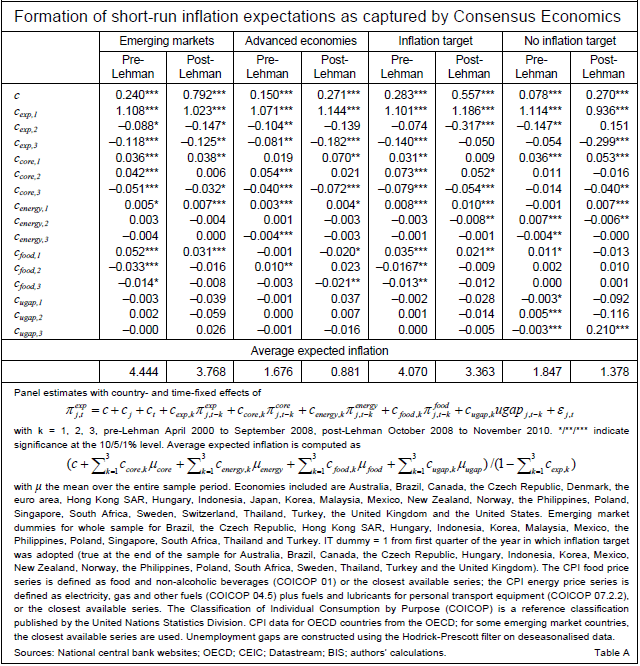Has there been a change in the formation of inflation expectations?
(Extract from pages 44-45 of BIS Quarterly Review, March 2011)
Changes in the expectations formation process can affect the dynamics of inflation itself. For monetary policymakers who seek to stabilise inflation two to three years out, such a change might signal the need to adjust the way in which they react to shocks.
There are a number of ways in which the financial crisis could have affected how inflation expectations are formed. The public may have changed its understanding of how monetary policy works. The deep recession in major advanced economies could have changed assessments of the growth rate of potential output. Or rapid real growth in emerging markets may have altered the dynamics of commodity and food prices, changing the way in which agents form their inflation expectations.
Galati et al (2009) analyse how long-run inflation expectations changed during the financial crisis. Using bond- and swap-based expectations measures, they find that expectations in the euro area, the United Kingdom and the United States have started responding more strongly to macroeconomic news. In principle, such news should have no impact if long-run inflation expectations are well anchored.
Table A presents a simple econometric analysis of the formation process of short-run inflation expectations. The analysis uses monthly data on expectations for the year ahead from 25 countries from 2000 onwards.1 The table provides a breakdown between emerging and advanced economies, on the one hand, and between inflation targeting nations and other economies, on the other hand, since it seems likely that the average rate of inflation differs between these groups. For all breakdowns, estimates are reported for before and during the great recession.
Before the crisis, inflation expectations evolved in similar ways in the different country groups. Consensus Economics inflation forecasts seemed to be autocorrelated and to depend on lagged core, energy and food price inflation.2 Average inflation expectations appeared lower in advanced economies and countries without an inflation target, and they seemed to follow a hump-shaped pattern in response to shocks. Core, energy and food price inflation tended to increase inflation expectations initially but to reduce them after two to three months. Thus, it appeared that changes in the rate of food and energy price inflation, rather than their rate of inflation itself, affected expectations. The impact of food prices was particularly large in emerging markets. Finally, inflation expectations in non-inflation targeting countries seemed to depend on the unemployment gap: when unemployment increased above its long-term trend, inflation expectations tended to decline.3
Since the onset of the great recession, average inflation expectations have apparently decreased across the board, a result that seems largely driven by the reduced impact of food price inflation. This weaker response of inflation expectations may in turn be a reaction to the increase in the volatility of food price inflation in recent years. Further, in economies without an inflation target, inflation expectations seem to have stopped following a hump-shaped response to shocks. This may suggest that forecasters have started to view inflation itself as less sluggish than before the crisis. Alternatively, they may today rely more on new economic information when forming inflation expectations and less on their own past forecasts. It remains to be seen if these changes in the formation of inflation expectations have modified the dynamics of inflation itself.
1 Consensus Economics provides forecasts for the current calendar year and the coming one. In January 2011, expectations for the year ahead are simply given by the Consensus 2011 forecast. In February 2011, expectations for the year ahead are computed as a weighted average of the Consensus 2011 and 2012 forecasts, with the former assigned a weight of 11/12 and the latter a weight of 1/12. These weights shift as the year progresses: in December, they are 1/12 and 11/12, respectively.
2 The analysis uses three lags. Further lags were generally insignificant. Contemporaneous data for the right-hand side variables have been excluded to account for data collection and reporting lags. A level specification is chosen since it seems implausible to assume non-stationary inflation expectations over the relevant period.
3 Output gaps do not appear to affect inflation expectations. Since monetary regimes differ widely across the economies considered, policy rates are not included in the analysis. The effect of quantitative easing measures is not examined due to the small number of observations.

